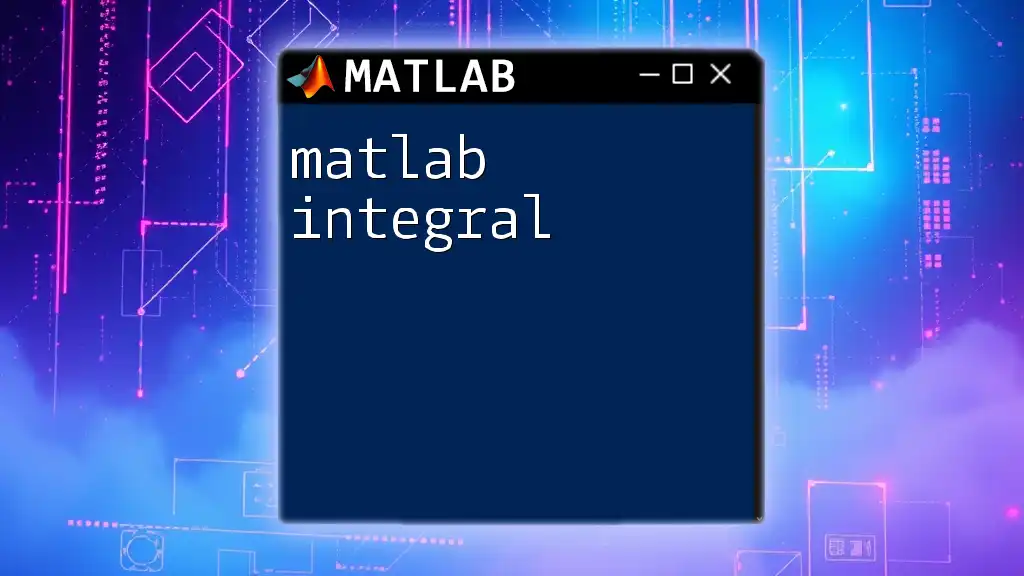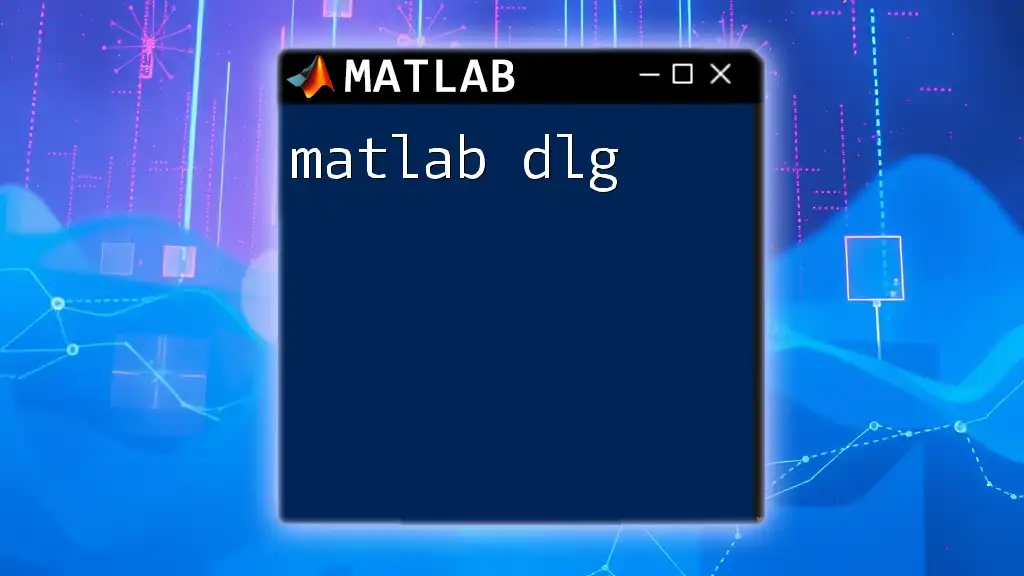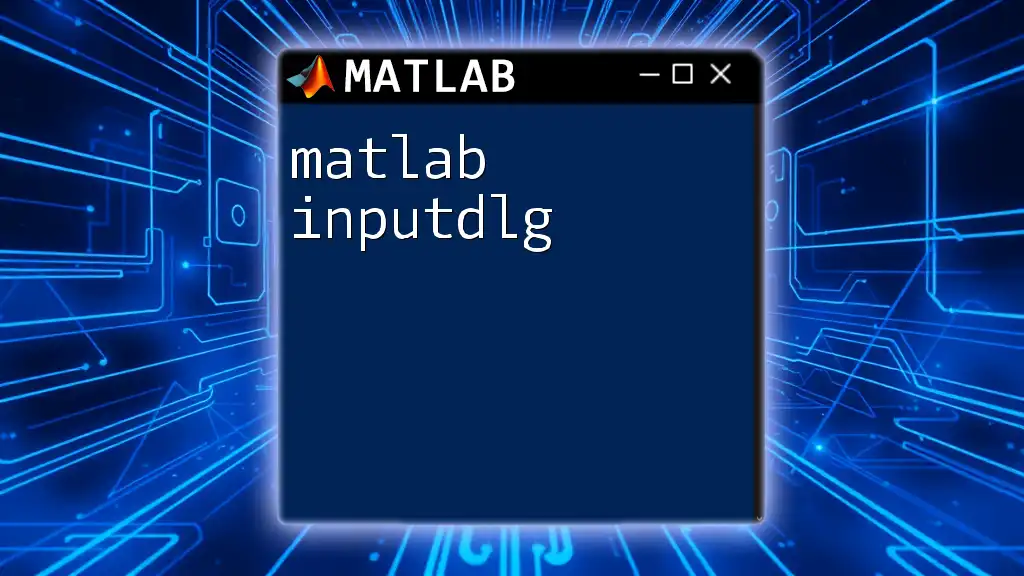The `inputdlg` function in MATLAB is used to create a dialog box that prompts the user to enter text input.
Here's a simple example of how to use the `inputdlg` function:
prompt = {'Enter your name:', 'Enter your age:'};
dlgtitle = 'Input Required';
dims = [1 35];
definput = {'John Doe', '25'};
answer = inputdlg(prompt, dlgtitle, dims, definput);
Using `inputdlg`
Basic Syntax
The MATLAB `inputdlg` function is essential for creating simple input dialogs for gathering user input in your applications. The basic syntax is as follows:
inputdlg(prompt, title, dims, definput)
Here’s a breakdown of each parameter:
- `prompt`: A cell array of strings that describes what you want the user to input. This is the message displayed in the dialog box.
- `title`: A string representing the title of the input dialog. It appears at the top of the dialog window and can guide users on the nature of the input required.
- `dims`: A two-element vector that defines the size of the input fields. This allows you to control how many lines each input box will have and their width.
- `definput`: A cell array representing the default input values that appear in each input field. This is particularly useful when prompting the user for values previously entered or anticipated.
Understanding Each Parameter
Prompt
The prompt parameter is crucial because it guides the user on what information is expected. A prompt can take various forms, such as:
prompt = {'Enter your name:', 'Enter your age:'};
This will create two input fields, one for the name and another for the age. Clear prompts can significantly enhance user experience, making it easier for users to understand what inputs are needed.
Title
The title parameter adds a level of professionalism and clarity to your dialog. An effective title could simply be:
title = 'User Information';
Choosing an informative title helps users understand the dialog’s purpose immediately.
Dimensions
Dimensions control the layout of the input dialog. For instance, if you want a single-line input for names and a multi-line input for comments, you can specify:
dims = [1 50; 5 50];
This command sets the first input to be one line high and 50 characters wide, while the second input has a height of five lines and the same width.
Default Input
Providing default input is valuable for streamlining the user experience. Here’s how you set it up:
definput = {'John Doe', '30'};
In this case, “John Doe” and “30” appear in the respective input fields. Users can accept and modify these values, which can save time in repeated data entry scenarios.

Building Effective Dialogs
Design Considerations
When building effective input dialogs, focus on clarity and simplicity. Keep prompts concise and lead the user with relevant questions. For example, rather than saying "Input your current status," you might say "Enter your current job title."
Multiple Input Handling
Using `inputdlg` to collect multiple inputs in one dialog enhances user efficiency. The following example captures a user's name, age, and favorite color all at once:
prompt = {'Enter your name:', 'Enter your age:', 'Enter your favorite color:'};
title = 'User Details';
dims = [1 35; 1 35; 1 35];
definput = {'John Doe', '30', 'Blue'};
userInput = inputdlg(prompt, title, dims, definput);
This creates a streamlined input process for the user, allowing them to enter all information in one go.
Validations and Constraints
Input validation is essential for ensuring the integrity of data collected from users. After retrieving inputs, you can implement checks like so:
age = str2double(userInput{2});
if isnan(age) || age <= 0 || age > 120
errordlg('Please enter a valid age between 1 and 120.','Input Error');
end
This code checks whether the entered age is a number within a realistic range. Handling invalid inputs proactively leads to a smoother user experience.

Advanced Usage of `inputdlg`
Customizing Appearance
While `inputdlg` has a standard appearance, you might want to customize aspects of it. While more advanced customizations (like changing colors) may require a different function, you can control size and layout through `dims` parameters.
Using with Callbacks
Integrating `inputdlg` with callbacks allows greater interactivity in GUI applications. For instance, if you're developing a graphical user interface (GUI) and want to capture user input when a button is pressed, you can create a callback function like this:
function myCallback(hObject, eventdata)
prompt = {'Enter value:'};
title = 'Input';
definput = {'10'};
userInput = inputdlg(prompt, title, [1 35], definput);
% Additional logic to process userInput
end
This makes your application much more dynamic and user-friendly by responding to user interactions in real-time.

Common Use Cases
Real World Applications
The `inputdlg` function finds application in various fields:
- Engineering: Collect parameters for simulations.
- Data Analysis: Request specific values for data filtering.
- User Surveys: Ask users to input feedback conveniently.
Implementing `inputdlg` in different scenarios not only gathers necessary data but also increases user engagement.

Troubleshooting Common Issues
Debugging Input Dialogs
Using `inputdlg` can sometimes lead to unexpected problems. Here are common pitfalls to watch out for:
- User Cancelation: If the user hits cancel, `inputdlg` returns an empty cell array. Always check for this before proceeding with data processing.
- Incorrect Data Types: Ensure you convert inputs to the correct data types (such as numbers). Always validate input to prevent runtime errors.
By addressing these issues preemptively, you can enhance the robustness of your application.

Conclusion
The MATLAB `inputdlg` function is a powerful tool for creating interactive user interfaces that enhance your applications. By mastering the parameters and best practices outlined in this guide, you'll be well-equipped to gather user input effectively.
Encouragement for Further Learning
There’s much more to learn about the capabilities of MATLAB. Experimenting with various functions and incorporating user dialogs can lead to improved applications. Check out additional resources or courses we offer to deepen your MATLAB knowledge and skills.

Code Snippets Repository
Here’s a collection of useful `inputdlg` snippets for various scenarios to inspire and guide your implementation:
% Example of a basic input dialog
prompt = {'Enter your name:'};
title = 'Name Input';
definput = {'Default Name'};
userName = inputdlg(prompt, title, [1 50], definput);
Explore and customize these examples to fit your needs, and remember that practice is key to becoming proficient in MATLAB.

















